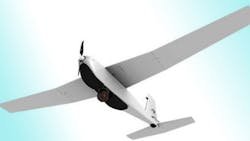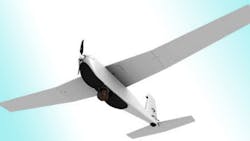A recent outdoor test flight of a solar-powered prototype version of the AeroVironment’s proven Puma AE™ small unmanned aircraft system (UAS), operating with the company’s newest long-endurance battery, lasted 9 hours, 11 minutes – significantly longer than the flight endurance of small UAS being used in the field today. Fig. 1 shows the Puma AE.
AeroVironment is working with Alta Devices, a Sunnyvale, Calif. company that provides flexible, portable power that can be embedded into any other material, in the development of the solar Puma AE.
“This is a critical milestone with far-reaching implications for the many ways small UAS can benefit military, public safety and commercial customers,” said Roy Minson, AeroVironment senior vice president and general manager, Unmanned Aircraft Systems (UAS). “The solar Puma AE is the latest example of AeroVironment’s longstanding commitment to deliver important, innovative solutions that meet our customers’ needs.
“Our integration of this cutting-edge technology dramatically increases Puma’s current flight endurance using a clean, renewable power source,” Minson added, “this development can give Puma AE customers significantly increased capabilities that approach those of the next class of UAS at a much lower acquisition and operating cost, and with much greater operational flexibility.” AeroVironment’s new long endurance battery extends Puma AE’s non-solar endurance to more than three hours. This means small UAS could be used for longer missions over greater distances than previously possible.
Minson added that past solar solutions for powering small UAS were either too heavy or did not produce enough power for long-range flight – or both. “However,” he said, “the solar Puma AE technology can produce enough power, while adding negligible weight, so that endurance is no longer an issue for most customer missions.”
Using a proprietary and highly differentiated technology, Alta Devices manufactures the world's thinnest and highest efficiency solar cells using Gallium Arsenide. This technology significantly extends the battery life of any application, in many cases eliminating the need to recharge from the grid because it converts more light into electricity. Solar material like that used in the development of the solar Puma AE incorporates a thin, mobile power technology on a flexible substrate that has been independently certified by the National Renewable Energy Laboratory (NREL) as world-records for both single (28.8%) and dual (30.8%) junction solar cells.
Puma AE is a flexible, efficient and rugged hand-launched workhorse for intelligence, surveillance and reconnaissance (ISR). This solar-power enhancement makes it even more indispensible for U.S. and allied military, as well as for domestic public safety applications, such as firefighting, law enforcement, search and rescue, oil and gas field monitoring, and other commercial needs.
The solar Puma AE configuration currently is in the research and development phase. A production version is planned for early 2014.
The 13-pound Puma AE is fully waterproof, man-portable and can be assembled in minutes, hand-launched, operated and recovered on sea or land by a team of two people. It requires no infrastructure, such as runways, launching pads or recovery devices. In addition, the system is quiet and operates autonomously, providing persistent observation data.
In July, AeroVironment received a “Restricted Category” rating for its Puma AE small UAS from the Federal Aviation Administration. The first-of-its-kind certificate permits operators to fly Puma AE for commercial missions in regions of the Arctic.
Bigger Drones
A solar-powered high-altitude drone made by Titan Aerospace (Fig. 2) is intended to be able to remain in flight for about five years. When manufactured, it would have 3,000 solar panels producing about 7 kW of electricity and would be above the clouds, so it would be exposed to sunlight constantly during daylight hours. One is scheduled for completion next year.
The point of having such a plane would be to keep a payload in flight long-term, presumably in a manner similar to communications satellites. They could be used for surveillance applications such as environmental monitoring, fire monitoring and disaster response, among other things.
Using a long-term solar drone/plane also has the advantage of being a vessel that can be safely brought back down to ground level, so old payloads can be offloaded, or repaired. News ones can be put in place and then the plane can re-ascend to continue its solar-powered flight.
Another potential advantage is cost. Some satellites cost hundreds of millions of dollars. Just getting them up to the desired altitude can be extremely expensive. One they are there, they can be damaged or break down and they become space junk.
About the Author

Sam Davis Blog
Editor-In-Chief - Power Electronics
Sam Davis was the editor-in-chief of Power Electronics Technology magazine and website that is now part of Electronic Design. He has 18 years experience in electronic engineering design and management, six years in public relations and 25 years as a trade press editor. He holds a BSEE from Case-Western Reserve University, and did graduate work at the same school and UCLA. Sam was the editor for PCIM, the predecessor to Power Electronics Technology, from 1984 to 2004. His engineering experience includes circuit and system design for Litton Systems, Bunker-Ramo, Rocketdyne, and Clevite Corporation.. Design tasks included analog circuits, display systems, power supplies, underwater ordnance systems, and test systems. He also served as a program manager for a Litton Systems Navy program.
Sam is the author of Computer Data Displays, a book published by Prentice-Hall in the U.S. and Japan in 1969. He is also a recipient of the Jesse Neal Award for trade press editorial excellence, and has one patent for naval ship construction that simplifies electronic system integration.


